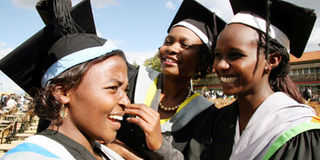New measures proposed to improve quality of higher education

Graduands during a past graduation ceremony at Egerton University. Kenyans wishing to teach in universities will be required to have at least a Master’s degree once new regulations are gazetted. PHOTO/FILE
What you need to know:
- Doctorate students will be taught by lecturers with at least five years teaching experience and evidence of research inclination through individual research and supervision.
- The Pure and Natural Sciences lecturer to student ratio should be 1:10 and the Social Sciences 1:18.
Kenyans wishing to teach in universities will be required to have at least a Master’s degree once new regulations are gazetted.
The regulations were developed by universities and the Commission for University Education. They further require academic courses to be offered by qualified full-time staff.
“The minimum academic qualifications of academic staff shall be at least one level above what he or she is supposed to teach,” states the new university regulations.
Only lecturers with doctorates with at least three years teaching experience and evidence of research, academic supervision and involvement in peer reviewed publications will be allowed to teach Master’s students.
Doctorate students will be taught by lecturers with at least five years teaching experience and evidence of research inclination through individual research and supervision.
The regulations further prescribe that an academic course be headed by a full-time appropriate and qualified senior lecturer and above with at least five years university teaching experience and a doctoral degree in the field.
“The ratio for full-time to part-time staff for the support of any programme should be 2:1,” the regulations state.
The ratio of full-time staff to students for Applied Sciences has been proposed to be 1:10, while in the Arts and Humanities, there will be one for every 15 students. For Medical and Allied Sciences, the proposed ration is 1:7.
The Pure and Natural Sciences lecturer to student ratio should be 1:10 and the Social Sciences 1:18.
An academic staff will be assigned students to supervise on thesis and dissertation based on his or her teaching load, administrative duties and supervision experience and capacity.
The regulations also set the maximum number of students an academic staff will be assigned a year to be five for Master’s studies and three for doctorate.
The maximum lecturer workload will be 40 hours a week, which will include time for teaching, preparation and marking of examination scripts, tutorials, preparation for teaching, supervision of academic work, administration, laboratory work and research assignments.




